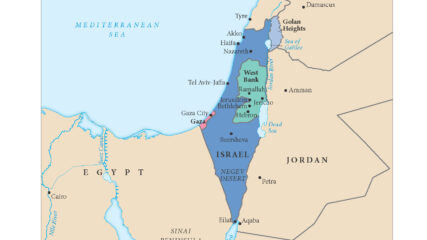Dan Diker, Jerusalem Center for Public Affairs, February 4, 2020
With permission, read full article at JCPA.
Institute for Contemporary Affairs
Founded jointly with the Wechsler Family Foundation
Vol. 20, No. 2
- The U.S. peace plan offers a return to the security-first approach of former Prime Minister Yitzhak Rabin and, specifically, the concept of defensible borders.
- On Jan. 29, 2020, Shimon Sheves, former Director-General of Prime Minister Rabin’s office, told Israel Army Radio, “The Trump plan is essentially the Rabin plan” and a “continuation of Rabin’s legacy.” Journalist Ben Caspit, writing in Maariv, called it “a modern incarnation of Rabin’s plan from 25 years ago.”
- During the ratification of the Oslo Interim Accords at the Knesset on Oct. 5, 1995, Rabin declared: “The borders of the State of Israel during the permanent solution will be beyond the lines that existed before the Six Day War. We will not return to the June 4, 1967 lines.”
- Rabin continued: “The security border of the State of Israel will be located in the Jordan Valley in the broadest sense of that term.” He emphasized that Jerusalem would remain Israel’s united capital. Regarding the Palestinian entity, Rabin told the Knesset, “We would like this to be an entity that is less than a state, and which will independently run the lives of the Palestinians under its authority.”
- The defensible borders concept was first formally outlined following the 1967 war by Gen. Yigal Allon, who presented it to Western audiences in Foreign Affairs in 1976. He posited that Israel needed to retain a topographical barrier to defend itself from attacks from the east. Allon insisted on Israel annexing the entire Jordan Rift Valley, including the hilly terrain facing eastwards toward Jordan, as well as the Jordan Valley below.
- The U.S. peace plan means Israel is being asked to take unprecedented risks by living next to a sovereign Palestinian state in a Middle East plagued by radical regimes and failed states. That is why defensible borders are critical to guarantee Israel’s security.
Much has already been written about the U.S. administration’s recently published “Vision for Peace” in the Middle East. Most commentary has focused on the unprecedented U.S. recognition of Israel’s annexation of Jewish communities east of the 1967 lines and, simultaneously, Prime Minister Benjamin Netanyahu’s willingness to operationalize his 2009 Bar Ilan speech. In Washington, on January 28, 2020, he acceded to the establishment of a sovereign demilitarized Palestinian state in some 70 percent of the disputed West Bank, located in the center of Judea and Samaria, the heart of Israel’s Biblical homeland.
However, few observers have recognized the major paradigm shift that the U.S. administration’s peace plan signals in the long and largely failed history of Palestinian-Israeli diplomacy: a return to the security-first approach of the late Prime Minister Yitzhak Rabin, and specifically, the concept of defensible borders.
The U.S. plan should be closely compared to Rabin’s strategic approach to the Oslo Peace Accords that were first signed at the White House in 1993, and then detailed in 1995 interim accord between Rabin and PLO Chairman Yasser Arafat, under the stewardship of U.S. President Bill Clinton. On January 29, 2020, the day after the Trump plan was published, Shimon Sheves, former Director-General of Prime Minister Rabin’s office and one of his closest advisors, told Israel’s Army Radio’s evening news program, “The Trump plan is essentially the Rabin plan.” While critical of Prime Minister Netanyahu’s unilateral acceptance of the plan, Sheves still noted that the Trump plan is a “continuation of Rabin’s legacy.”1
Similarly, Ben Caspit, one of Israel’s leading journalists known for his unrelenting criticism of Netanyahu, penned a generally positive assessment of the Trump plan in the Maariv daily, calling it “a modern incarnation of Rabin’s plan from 25 years ago.”2
What was Rabin’s defensible borders approach to Oslo that today appears to anchor the U.S. administration’s approach to a peace deal with the Palestinian leadership?
Rabin had presented his vision of a final status peace deal during the ratification of the Oslo Interim Accords at the Knesset on October 5, 1995, just three weeks before his tragic assassination. Speaking from the Knesset podium, Rabin told the packed plenum, “The borders of the State of Israel during the permanent solution will be beyond the lines that existed before the Six Day War. We will not return to the June 4, 1967 lines.”
It should be noted that since 2017, when the Trump plan was initiated, U.S. peace interlocutors undertook a two-year “listening tour” in Israel and the Middle East, and had been advised that Rabin, in line with every Israeli prime minister since the fateful days of the 1967 war, had rejected an Israeli return to the unstable and indefensible pre-1967 war lines, providing an important point of reference for the current U.S. vision. Former Foreign Minister Abba Eban had famously referred the pre-1967 lines as “Auschwitz borders.” In 1995, Rabin further declared to the Knesset plenum, “The security border of the State of Israel will be located in the Jordan Valley in the broadest sense of that term.” And serving as a precursor to the Trump vision, Rabin also emphasized that Jerusalem would remain Israel’s united capital.3
The Doctrine of Defensible Borders
Rabin’s insistence, 25 years ago, on Israeli control of the strategically vital Jordan Rift Valley, was an antecedent to Trump’s proposal of Israeli sovereignty in the Jordan Valley, both of which were rooted in the doctrine of defensible borders.

The Israeli strategic doctrine of defensible borders at Oslo, now readopted in the Trump proposal, constitute a return to a “security-first” approach to peace negotiations. This term was referenced by former Defense Minister and IDF Chief of Staff Moshe “Bogie” Yaalon following several failed attempts at reaching diplomatic agreements with the Palestinians. These Israeli peace proposals, beginning with former Prime Minister Ehud Barak’s offer at the Taba Summit in 2001, had shelved the defensible borders approach in favor of the far riskier plan of “security arrangements,” which Palestinian negotiators also rejected.4
The U.S. re-adoption of Rabin’s defensible borders doctrine also helps explain why Yaalon’s fellow leaders of the Blue and White Party, former IDF Chiefs of Staff Benny Gantz and Gabi Ashkenazi, also embraced the Trump plan’s call for Israeli annexation of the Jordan Valley and the northern Dead Sea basin. Notably, both Gantz and Ashkenazi have even incorporated Rabin’s nomenclature, calling for the Jordan Valley to be Israel’s “eastern security border.”5
Some commentators have mistakenly focused on the issue of settlements intertwined in the Trump plan’s annexation proposal for the Jordan Valley. However, the Jordan Valley is one of the least populated areas in the West Bank and only includes some 5,500 Israeli residents. That is why the strategic importance of the Jordan Valley has been emphasized by Israel’s political and military leadership since 1967 – including the leadership of both major political parties.
The defensible borders concept that Rabin embraced was first formally outlined as a national security plan following the 1967 war by Gen. Yigal Allon, Rabin’s commander in the pre-state Palmach strike force, who subsequently served as Rabin’s Foreign Minister. Allon emphasized the importance of defensible borders to Western audiences in a 1976 issue of Foreign Affairs. He posited that Israel needs to retain a topographical barrier to defend itself from attacks from the east, a move that would constitute an additional defensive measure beyond insisting on the demilitarization of Palestinian independent areas or, in today’s terms, a proposed sovereign Palestinian state.

Allon and Rabin were particularly concerned at the prospect of hostile forces, and today terror groups or individual terrorists, firing rockets and anti-aircraft weaponry from the hilltops of the steep 3,200-foot high West Bank mountain ridge that overlooks Israel’s narrow coastal plain, that contains Israel’s major cities, 70 percent of Israel’s residents, 80 percent of its industrial capacity, major highways and infrastructure, and particularly, Israel’s major airport.

Allon had insisted on Israel annexing the entire Jordan Rift Valley, including the hilly terrain facing eastwards toward Jordan, as well as the Jordan Valley below, constituting some 33 percent of the West Bank. This is virtually identical to the 30 percent of the territories the U.S. plan calls for today. While Rabin had been less specific about annexing of the entire area, the Allon plan, Rabin’s security doctrine at Oslo, and the current U.S. plan are all anchored in the concept of defensible borders. They saw that the Jordan Valley and the adjoining eastern hill ridge formed a natural topographical security wall that would protect Israel’s main airport and Mediterranean coastal cities from rocket, mortar, and anti-aircraft assault by terrorists firing down from West Bank hilltops.6
Rabin’s Oslo plan opposed Palestinian sovereignty. Rabin told the Knesset plenum, “We would like this to be an entity that is less than a state, and which will independently run the lives of the Palestinians under its authority.”7
The Trump plan’s defensible borders concept for Israel is anchored in Israeli sovereignty in the Jordan Valley and Northern Dead Sea area. In contrast, Rabin had envisioned an Israeli “security border” in the Jordan Valley, which did not require full Israeli sovereignty. Israeli defensible borders notwithstanding, the current U.S. plan, departing from Rabin’s vision of Palestinian autonomy, also establishes a blueprint for a sovereign Palestinian state, with a land connection to Gaza and additional swapped sovereign territory in the Western Negev. For his part, Rabin had sought to maintain an Israeli security presence and Jewish communities in parts of Gaza. Rabin also did not entertain land swaps from pre-1967 Israel.
Why Six Negotiating Experiences Failed
While defensible borders anchored both Oslo and the current U.S. plan, the past 25 years have witnessed six failed attempts by three U.S. presidents to reach a peace agreement between the Palestinian Authority and Israel since the signing of the Oslo Exchange of Letters in September 1993. In each instance, the Palestinian leadership turned down U.S.-mediated offers for sovereign independence. The Palestinian rejections of diplomatic compromises included: Clinton’s Camp David Summit in 2000, the Taba talks in 2001, President George W. Bush’s Road Map in 2003, the U.S.-brokered Israeli Gaza withdrawal in 2005, the Annapolis peace summit in 2008, and the Kerry peace initiative under President Barak Obama in 2014.
The U.S. administration’s latest approach, therefore, has shifted the paradigm for peace by recognizing Jewish historical and legal rights to sovereignty on both sides of the 1949 armistice lines, thereby eliminating the false international assumption that the Palestinians exclusively possess legal rights in the disputed territories.
Second, the Trump plan’s re-adoption of Israel’s national consensus doctrine of defensible borders for Israel via Israeli annexation of the Jordan Rift Valley will enable Israel to secure its sovereignty while enabling Israel to “defend itself by itself.” This ironclad national security principle has always been an essential Israeli pre-condition to making any substantial concessions and taking significant additional risks for peace. Today, with the publication of the U.S. plan, Israel is taking unprecedented risks in considering the prospect of living next to a sovereign Palestinian state, particularly in a Middle East region that is plagued by radical regimes, proxy forces, political instability, and failed states. That is why defensible borders are critical in providing the essential protections that are a guarantor of an Israeli-Palestinian peace that will be lasting and durable.
* * *
Notes
1 https://blogs.timesofisrael.com/the-man-who-incited-now-rejoices/
2https://www.maariv.co.il/journalists/Article-743899
3 Israel’s Requirements for Defensible Borders, (Dan Diker Ed.) Jerusalem Center for Public Affairs, 2014, p. 9.
4 See, Moshe Yaalon, “Restoring a Security First Peace Policy” in Israel’s Requirement for Defensible Borders, 2014, Jerusalem Center for Public Affairs p. 10. https://www.jcpa.org/text/security/yaalon.pdf
5 https://www.jns.org/how-the-former-generals-of-the-blue-and-white-party-view-the-palestinian-issue/
6 Moshe “Bogie” Yaalon, former Defense Minister, Chief of Staff and Head of the IDF Intelligence Directorate used the term “Security-first” to refer to the return to a defensible borders approach following the failed shift in strategy by former Prime Minister Ehud Barak at the 2000 Camp David and subsequently a the Taba negotiations away from defensible borders, and instead adopted the concept of “security arrangements” that would have placed IDF troops and early warning stations on the territory of a Palestinian sovereign state. Palestinian leaders rejected Barak’s security arrangements proposal out of hand, thereby pocketing additional territorial concessions and launching a war of terror that claimed hundreds of Israeli lives to Palestinian terror from 2001 to 2004. See Moshe Yaalon, “Restoring a Security First Peace Policy” in Israel’s Requirement for Defensible Borders, 2014, Jerusalem Center for Public Affairs p.7 https://www.jcpa.org/text/security/yaalon.pdf
7 Yaalon, p. 10.









